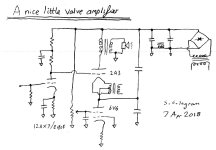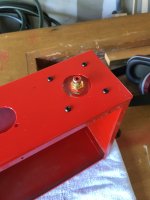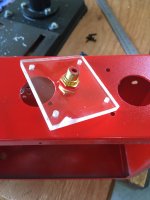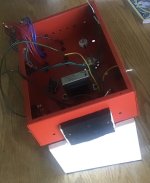E180F sounded glorious to me, though not necessarily low distortion. Shootout between E180F, 6N6P, 6Z51P, 6J5.
None of them sounded bad. E180F I found to be special, but 6J5 and 6Z51P cleaner and more neutral to my ear.
This was also in a shootout where I varied using just a cathode resistors (for above-mentioned tubes) and LEDs. LEDs were so much better with respect to bass. Relevant to this discussion, all tubes were loaded with Ale Moglia's gyrators. I think they sound great with my 6J5 but there are many parts and I have experienced two failures (both my fault). If a tube CCS can replace one with decent sound, I'd probably do that in a subsequent build instead of a gyrator.
I'm very curious about how this will sound. Would much rather use a tube than a solid-state CCS for heat dissipation reasons, just as you say, though you will of course have additional heat under the chassis by adding another tube.
IMO embrace putting cathode resistors on top or building into the design, somehow. Recently reworked a PSU and added two new resistors that get pretty hot. They are under the chassis and ventilated with holes but the chassis still gets plenty warm in that area.
Looked at a couple resources for vacuum tube-based CCS. One of course is Mr Tubelab:
- http://tubelab.com/articles/circuits/ccs-circuits/
Also found an interesting post in this thread. It sounds like a tube CCS offers substantially lower output impedance. I wonder about two aspects of a 2A3 stacked on a 6V6:

None of them sounded bad. E180F I found to be special, but 6J5 and 6Z51P cleaner and more neutral to my ear.
This was also in a shootout where I varied using just a cathode resistors (for above-mentioned tubes) and LEDs. LEDs were so much better with respect to bass. Relevant to this discussion, all tubes were loaded with Ale Moglia's gyrators. I think they sound great with my 6J5 but there are many parts and I have experienced two failures (both my fault). If a tube CCS can replace one with decent sound, I'd probably do that in a subsequent build instead of a gyrator.
I'm very curious about how this will sound. Would much rather use a tube than a solid-state CCS for heat dissipation reasons, just as you say, though you will of course have additional heat under the chassis by adding another tube.
IMO embrace putting cathode resistors on top or building into the design, somehow. Recently reworked a PSU and added two new resistors that get pretty hot. They are under the chassis and ventilated with holes but the chassis still gets plenty warm in that area.
Looked at a couple resources for vacuum tube-based CCS. One of course is Mr Tubelab:
- http://tubelab.com/articles/circuits/ccs-circuits/
Also found an interesting post in this thread. It sounds like a tube CCS offers substantially lower output impedance. I wonder about two aspects of a 2A3 stacked on a 6V6:
- Does this require a higher B+ for the 2A3, then, as you need ~200V on the plate of the 6V6, which would also be the filament ground for the 2A3?
- https://www.audioasylum.com/cgi/vt.mpl?f=tubediy&m=251856
Member
Joined 2009
Paid Member
Interesting you should mention it, but I still have a keen interest in the 2018 the design for this project included just that, a 6V6 underneath the 2A3 specifically to keep the heat above the chassis.
However, it adds more heater power and current demand to the power trafo via the heater winding. It remains of intellectual interest but I’m not concerned about a cathode resistor in this project. Now, my chassis does have an Octal socket for the rectifier. If I went with a SS only rectifier, I could use that socket for a 6V6. Hmmmmmmmm?
However, it adds more heater power and current demand to the power trafo via the heater winding. It remains of intellectual interest but I’m not concerned about a cathode resistor in this project. Now, my chassis does have an Octal socket for the rectifier. If I went with a SS only rectifier, I could use that socket for a 6V6. Hmmmmmmmm?
Attachments
Member
Joined 2009
Paid Member
or a damper/rectifier diode under the 2a3 . Hmmmmmm? : ). . . . . . .I could use that socket for a 6V6. Hmmmmmmmm?
You could also look at Gary Pimm's archived page.Looked at a couple resources for vacuum tube-based CCS.
A Google search on "Gary Pimm Pentode CCS" also turns up a lot of stuff.
Member
Joined 2009
Paid Member



